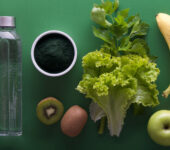
Photo by Madie Hamilton
How vital is iron for cycling performance? If you are an endurance athlete, female, vegetarian, or vegan, you may be at an increased risk for iron depletion. Iron depletion can progress to iron deficiency anemia. Iron is critical for athletic performance as it is part of proteins (hemoglobin and myoglobin) that deliver oxygen to muscles. Good muscle function and aerobic capacity depend on iron.
Symptoms of iron depletion/iron deficiency anemia
Symptoms of iron depletion may include:
- shortness of breath
- increased tiredness
- decreased athletic performance (increased or early fatigue during exertion)
- declined aerobic capacity
- decreased training adaptions
- decreased time to exhaustion
- GI upset
- poor memory and concentration
- diminished immune response and temperature control
- increased lightheadedness and koilonychia (spoon nails)
I have personally suffered from iron deficiency anemia before, and I felt cold all the time. I would tire quickly and was out of breath just walking up a flight of stairs. In addition, my legs hurt and burned all the time, no matter how many rest days I took.
Serum Ferritin
If you are concerned you may be at risk for iron depletion, ask your doctor to check your serum ferritin levels, which are your body’s iron stores. In addition, you can routinely check your hemoglobin. Still, it will not indicate depleted iron stores until they are so low you are anemic. Therefore, you can detect an iron depletion sooner if you examine serum ferritin levels.
Examining serum ferritin levels also means a quicker recovery time, which is essential for many athletes. Ideal serum ferritin levels for female athletes are greater than 35 ug/L and male athletes greater than 40 ug/L. Varying diagnostic definitions of iron deficiency anemia exist. Generally, a ferritin level lower than 12 ug/L defines iron deficiency. Anywhere in between those values is considered iron depletion.
Food Sources of Iron
Dietary Iron comes in two forms, Heme and Nonheme iron. Heme iron is found in meat and is more easily absorbed by the body. Animal liver contains the highest level of Heme Iron. Red meat (steak, roast beef, ground beef, bison) is a more commonly consumed source of iron. Heme iron is also found in oysters, pork, ham, tuna, salmon, and dark chicken meat or turkey.
Nonheme iron
Nonheme Iron is found in plants and other foods and is more difficult for the body to absorb. Iron-fortified cereals and bread, beans (lentils contain the highest amounts), spinach, peas, nuts, raisins, and tofu are a few foods that contain Nonheme iron.
Pairing foods with iron
Pairing foods containing iron with foods rich in vitamin C (such as citrus fruit, tomatoes, peppers) can increase iron absorption. Also, if you struggle with iron depletion, avoid consuming iron-containing foods with dairy, tea, coffee, or cocoa as they can impair absorption.
Lastly, cook your food in a cast-iron skillet as often as possible, especially acidic foods like tomato sauce. The iron can leach into the food giving you another good source of iron!
Supplementation
If you suffer from iron depletion or iron deficiency anemia, talk to your doctor to determine if an iron supplement is the right choice. Many forms of iron supplements exist. Consulting a doctor or a Registered Sports Dietitian to see which ones are right for you and least likely to cause gastrointestinal distress is a good idea. Also, speak to a dietitian about dietary changes and strategies to maximize your iron absorption.
Emily Werner
Emily is a Sports Dietitian who is passionate about helping others improve their health and athletic performance through proper nutrition. She races cyclocross professionally. She lives in Roanoke, VA with her husband Kerry and their beagle Sherman.
Get the email for busy mountain bikers.
Discover the best products + gear, and learn about deals from brands you love.









